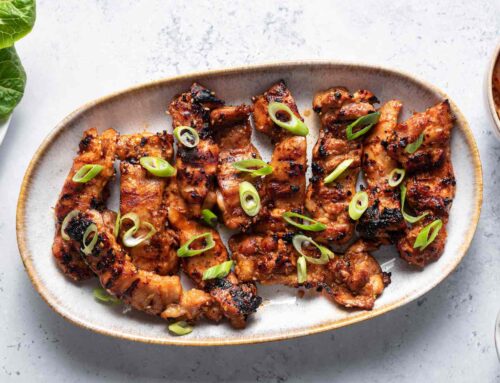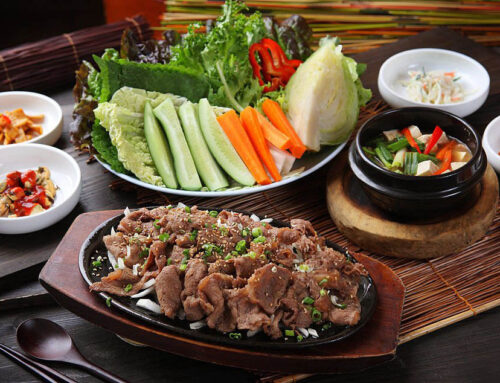What is Bulgogi?
Bulgogi, Korea’s treasured “fire meat,” is the crown jewel of Korean BBQ recipes. Originating from the regal tables of the Joseon dynasty, this once-royal delight now sizzles on grills across modern Korean streets.
The marinade, an exquisite blend of soy sauce, sugar, garlic, green onions, sesame oil, and spices, infuses the beef with a sweet and savory depth that’s irresistibly flavorful.
Today, while variants like Chicken Bulgogi and Pork Bulgogi are popular, it’s Beef Bulgogi that remains the undisputed classic—a must-savor experience that encapsulates the essence of Korean cuisine.

Bulgogi Variations
Bulgogi isn’t a one-size-fits-all Korean dish. Its preparation and flavor profile can vary from region to region in Korea. This leads to an enjoyable exploration of Korea’s traditional cooking methods.
1. TRADITIONAL KOREAN BBQ STYLE:
Thinly sliced beef is marinated in a flavorful sauce and typically requires a few hours for the beef to tenderize and absorb the marinade. Some add mushrooms and vegetables, but keeping the focus on the beef with a hint of green onion creates a balanced taste.
2. SEOUL-INSPIRED VARIATION:
A twist on the classic, this version incorporates sea kelp broth in the marinade. The beef is cooked on a special dome-shaped pan, channeling the meat juices and broth downwards, creating a rich, savory liquid perfect for drizzling over rice. Accompaniments often include Korean noodles , mushrooms, and vegetables.
3. CRISPY VERSION FROM JEOLLA PROVINCE:
This southern variant emphasizes a crispy exterior on the beef, achieved through a distinct cooking technique used in Jeolla Province. Unlike other versions, this Crispy Korean Beef doesn’t yield a juicy broth, but offers a satisfying crunch.
Choosing and Slicing the Beef
The choice of beef is a crucial factor in the taste and texture of your Korean BBQ dish. Typically, this traditional Korean dish utilizes thin slices of tender beef. Rib-eye or sirloin are often the preferred cuts for Bulgogi due to their perfect balance of lean meat and fat.
The rib-eye provides a wonderful blend of flavor and tenderness, while the sirloin offers a leaner option without compromising the juicy texture that makes Bulgogi so popular.
KOREAN-CUT FROZEN BEEF SLICES
You’ll want to slice the beef thinly against the grain for optimal marinade absorption, yielding a flavorful and tender result. This technique also promotes quick, even cooking.
However, if you’d rather skip the slicing, Korean stores often sell pre-sliced, frozen Bulgogi meat. Simply defrost and marinate for an authentic, hassle-free Korean BBQ experience.

Homemade Bulgogi Marinade
The secret to the perfect Korean Bulgogi lies in its marinade. Making your own sauce at home is simple, and it’s a game-changer compared to store-bought options. This homemade Bulgogi marinade doesn’t require complex steps, but it does ask for a little patience.
Aim to let your beef soak in this flavorful mix for at least 4 hours, but for the best results, letting it marinate overnight is the way to go. It’s a small step that promises big, delicious rewards.
Here’s what you’ll need for the marinade:

Cooking Techniques
When it comes to cooking Bulgogi, the method you choose plays a different role in the flavor and texture of the final dish.
GRILLING
Grilling Bulgogi over an open flame imparts a smoky, BBQ-like essence that’s hard to replicate with other methods. This technique allows the meat to develop a wonderful charred exterior while retaining a juicy and tender inside.
PAN FRYING
Pan frying is a convenient and quick way to cook Bulgogi, especially when a grill isn’t available. It still yields a delicious and flavorful dish, with the added benefit of easier clean-up and control.

Serving Suggestions
For a simple one-bowl meal, layer Bulgogi over white rice and serve with kimchi or another vegetable side dish.
Traditionally, Bulgogi is part of a complete meal, often paired with rice, fresh vegetables, and a variety of condiments. For a hands-on dining experience, wrap bulgogi, rice, green onion salad and a smear of ssamjang in lettuce leaves.
Accompanying it with a bowl of Korea soybean paste stew is a classic restaurant move that you can easily replicate at home.
But remember, the Bulgogi—tender, juicy, and richly marinated—is the true star. Enjoy your meal with these suggested Korean side dishes:



